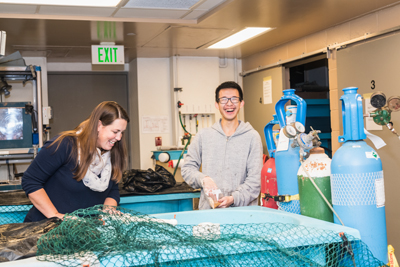Mount Allison researchers awarded NSERC grants in psychology, biology, and chemistry
 SACKVILLE, NB – Five Mount Allison University researchers were recipients of multi-year research grants from the Natural Sciences and Engineering Research Council of Canada (NSERC), announced earlier this summer. The funding will help support research programs across campus and includes the work of both faculty members and student researchers.
SACKVILLE, NB – Five Mount Allison University researchers were recipients of multi-year research grants from the Natural Sciences and Engineering Research Council of Canada (NSERC), announced earlier this summer. The funding will help support research programs across campus and includes the work of both faculty members and student researchers.
Mount Allison 2020 recipients include:
Dr. Irena Kaczmarska (biology)— Molecular and developmental approach to understanding diversification in mediophyte diatoms ($240,000 over six years)
Dr. Kaczmarska’s research focusses on diatoms, a type of single cell marine plant, which produce carbon and oxygen essential to keeping our Planet’s environment running as it has been for the past approximately 200,000 years. Kaczmarska and her research team are using a novel approach to learn more about diatoms, their evolution and diversity.
“A lot of work has been done using DNA analysis around diatoms,” explains Kaczmarska. “We, however, will use a developmental approach. Thinking about development, most of us think about how, for example, flowers, legs of horses, or wings of birds develop. However, in single celled organisms, the development also follows a series of identifiable and well-defined stages. This is what our earlier research has suggested, but we now want to test it further by applying the same principles to taxa critical in understanding major evolutionary transitions in diatom diversification.”
Kaczmarska, who also teaches courses in botany, marine botany, and paleontology, will normally have several Mount Allison undergraduate and master’s students working with her throughout the NSERC projects. Kaczmarska and her team have discovered a number of new diatom species over the years, including one that was named for Mount Allison — Paralia allisonii MacGillivary (Class of 2012) – in 2012.
Dr. Andrea Morash (biology) — The evolution of ketone body metabolism and hypoxia tolerance ($140,000 over five years + $12,500 additional early career research supplement)
Dr. Andrea Morash’s research program seeks to understand how animals respond to changing environments. She studies a wide range of aquatic species, including salmon, trout, sturgeon, and various shark species. This latest project will look at how fish respond to lower oxygen levels in water, a common situation around the globe as a result of climate change.
“We will be looking at how fish are responding to these environmental changes through a metabolic lens using tissue and blood samples from fish in the Maritimes, the West Coast, and Australia,” explains Morash. “We are specifically investigating the ketogenic (keto) response to low oxygen as ketone body metabolism has been found to be a very efficient to produce energy with less oxygen. By studying sharks – who use ketone bodies as part of their normal metabolism – along with other species like trout and sturgeon whose ketone body metabolism is limited, we can have an evolutionary perspective into ketone body metabolism and energy production during low oxygen conditions. We want to understand why different animals use ketone bodies in different ways, and if ketone bodies can help protect animals when they are exposed to low oxygen conditions. As yet, no one has investigated the ketogenic response in aquatic animals when oxygen is limited.”
Morash has also received funding from the New Brunswick Innovation Foundation and the Canadian Foundation for Innovation, which will help support her research program further with the purchase of new lab equipment.
Morash and her research team, which will include several Mount A students, will be analyzing tissue and blood samples from several aquatic species on campus as well as in the field, working on Vancouver Island and at the University of Tasmania, Australia, for shark samples when travel is feasible.
Dr. Jenny Wong (biochemistry and chemistry) — Sources and Impacts of Water-Soluble Iron in Atmospheric Aerosol ($120,000 over five years + $12,500 additional early career research supplement)
Water-soluble iron (WS-Fe) in atmospheric aerosol particles plays critical roles in climate, air quality and human health. Past research has focused on studying WS-Fe-containing mineral dust aerosol found in marine regions, as oceanic input of WS-Fe via aerosol deposition is a key controlling factor of ocean biological productivity and thus, climate. Growing epidemiological and toxicological evidence, however, demonstrates that exposure to WS-Fe-containing aerosol has important negative human health consequences because of the ability of WS-Fe to participate in reactions that lead to cellular oxidative stress and ultimately, cardiovascular inflammation and disease. The Global Burden of Diseases project has identified that aerosol in both outdoor and indoor environments are amongst the top ten leading factors of global premature morality.
Yet, there are major uncertainties associated with our understanding of the processes that govern the concentrations of WS-Fe in continental and indoor aerosol. Dr. Wong’s projects will seek to advance our fundamental understanding of aerosol chemistry, its impacts on health, and support of effective mitigation strategies.
Dr. Genevieve Desmarais (psychology) – Visuo-haptic object processing, memory representations and multisensory integration ($140,000 over five years)
Dr. Desmarais’s research program focusses on perception, how individuals interpret information they receive. She studies multi-sensory perception, like vision and touch, sight and sound and how your mind puts these together. When put together, sight is often dominant and can change the perception of another sensation; Desmarais is looking at what impacts how our minds do that integration.
Her latest project will look at the kind of memory we develop when we connect with objects including visualization methods and how our memory represents them. Desmarais and her research team, which includes several Mount Allison students, will undertake a number of studies over the next five years, focussing on how healthy young adults respond to memory testing and the kinds of errors or interpretations they make when relaying a memory of an object. Desmarais plans to submit her teams’ findings for publications once complete.
“Most perception in the last 100 years has focused on one sense at a time, and we only recently begun looking at how the mind integrates the different senses. If you think about it, it’s kind of amazing: we receive different kinds of information all at once, like seeing and touching an object, but our minds regroup these into a single perception seamlessly. I’m excited to be one of the few researchers looking at these integration processes with this additional support for the next five years.”
Dr. Terry Belke (psychology) was awarded a Discovery Development Grant for his project Properties of wheel running as reinforcement and as an operant. The two-year grant, valued at $30,000 will look at the value of running as a reward.
“We’re working to gain a better understanding of the value of the opportunity to run as a reward, it doesn’t work the same way as food,” explains Belke. “Using rats, we are looking to understand what underlies motivation to run and how this can be enhanced.”
Belke, who has researched learning, motivation, and physical activity throughout his career, will run his study in the Mount Allison lab, working with several students as research assistants.
“Running in a wheel for rats is not the same as running for humans because when we run the ground does not move as we move,” says Belke, “Over a series of experiments, we will work to gauge the value of, and motivation for, running in comparison to the value of other rewards such as food. We know that there’s a strong relationship between body weight and motivation to run. We are looking to learn more about this and ways rats adapt to different conditions around running and food.”
Along with a busy research program, Belke also teaches courses in conditioning, behaviour modification, and drugs and behaviour.
Pictured: File photo of Dr. Andrea Morash (biology) with a master’s student in Mount Allison’s Harold Crabtree Aqualab
NSERC National News Release: https://www.nserc-crsng.gc.ca/Media-Media/NewsDetail-DetailNouvelles_eng.asp?ID=1165




